Highlights of the Amsterdam Pipe Museum
Author:
Don Duco
Original Title:
Hoogtepunten uit het Amsterdam Pipe Museum
Publication Year:
2020
Publisher:
Amsterdam Pipe Museum (Stichting Pijpenkabinet)
A mysterious standard Gouda pipe
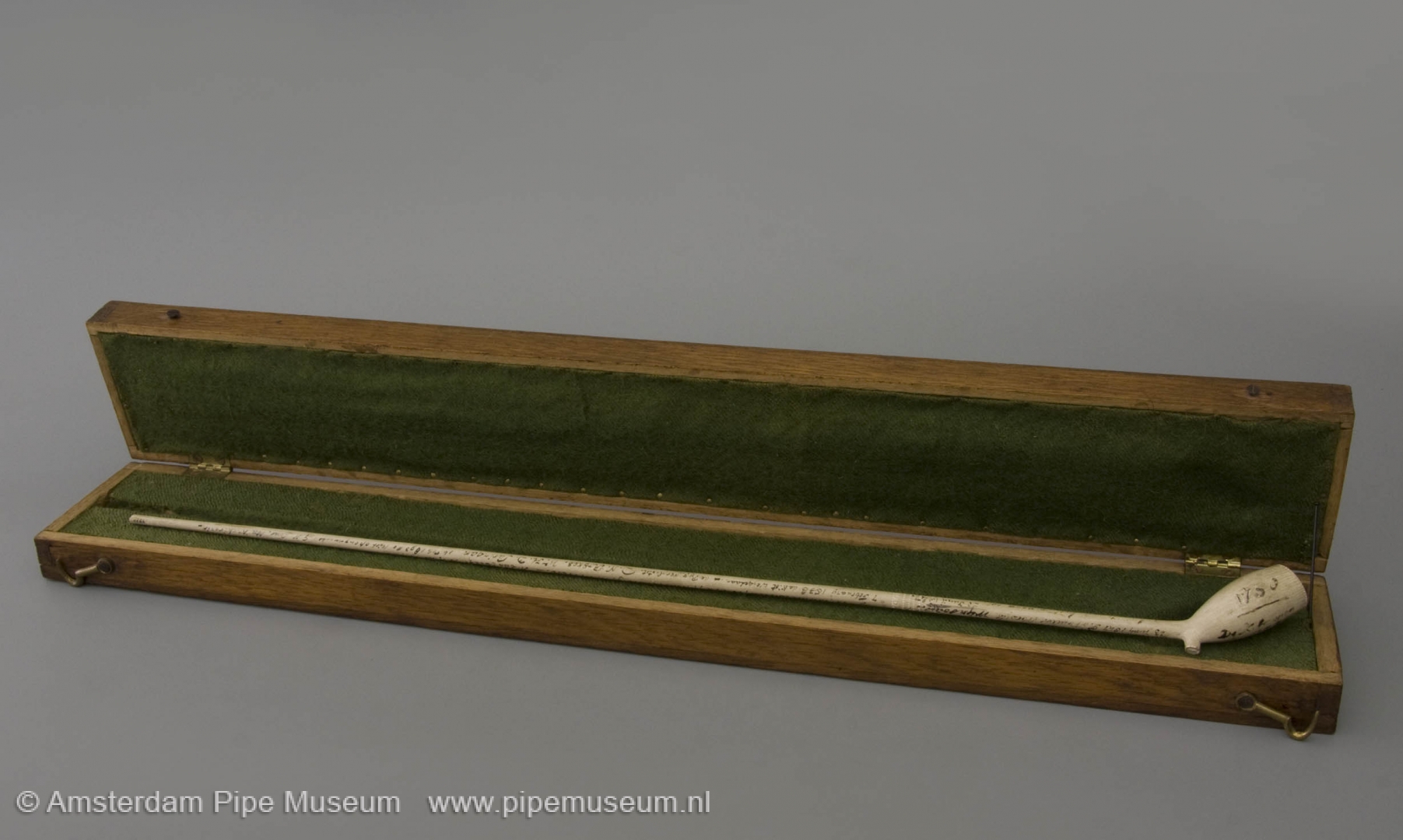
From the beginning of the eighteenth century, the name maatpijp, standard pipe is a well-defined concept. It is a long clay pipe from Gouda with a straight stem. Initially these pipes were 17 thumb or inches long, then 19 inches to end up at 21 inches or more than fifty centimetres. Pipes with this stem length and a standard oval bowl shape are the product of an industry with high product standardization and fierce competition. The maatpijp has been a common article for two centuries. Everyone knew them and liked to smoke it. The pipe tasted pleasant because of the long stem that cooled the smoke well.
There was always a fresh supply of this maatpijp and apparently nothing changed on the product. Therefor, no-one ever had a reason to preserve such a pipe as a time-bound object. The article was purchased over and over again and when in use these pipes were smoked up to the moment of breaking. All the more rare it is when by chance such an ordinary pipe has been preserved. That is what happend with the clay pipe depicted here, which is neatly protected for breakage in a wooden case and thus survived the centuries.
The elongated oak storage box, closing with two brass hooks, holds a cavity in which the pipe can safely rest, lined with green fabric. In this way the clay pipe remained intact and ultimately merited the predicate oldest preserved maatpijp in the world. Thanks to the makers mark, we know the origin. An imprint on the stem reads I: WOERLE and IN GOUDA which refers to the Gouda pipe maker Jan Woerlee, active from 1736 to 1777.
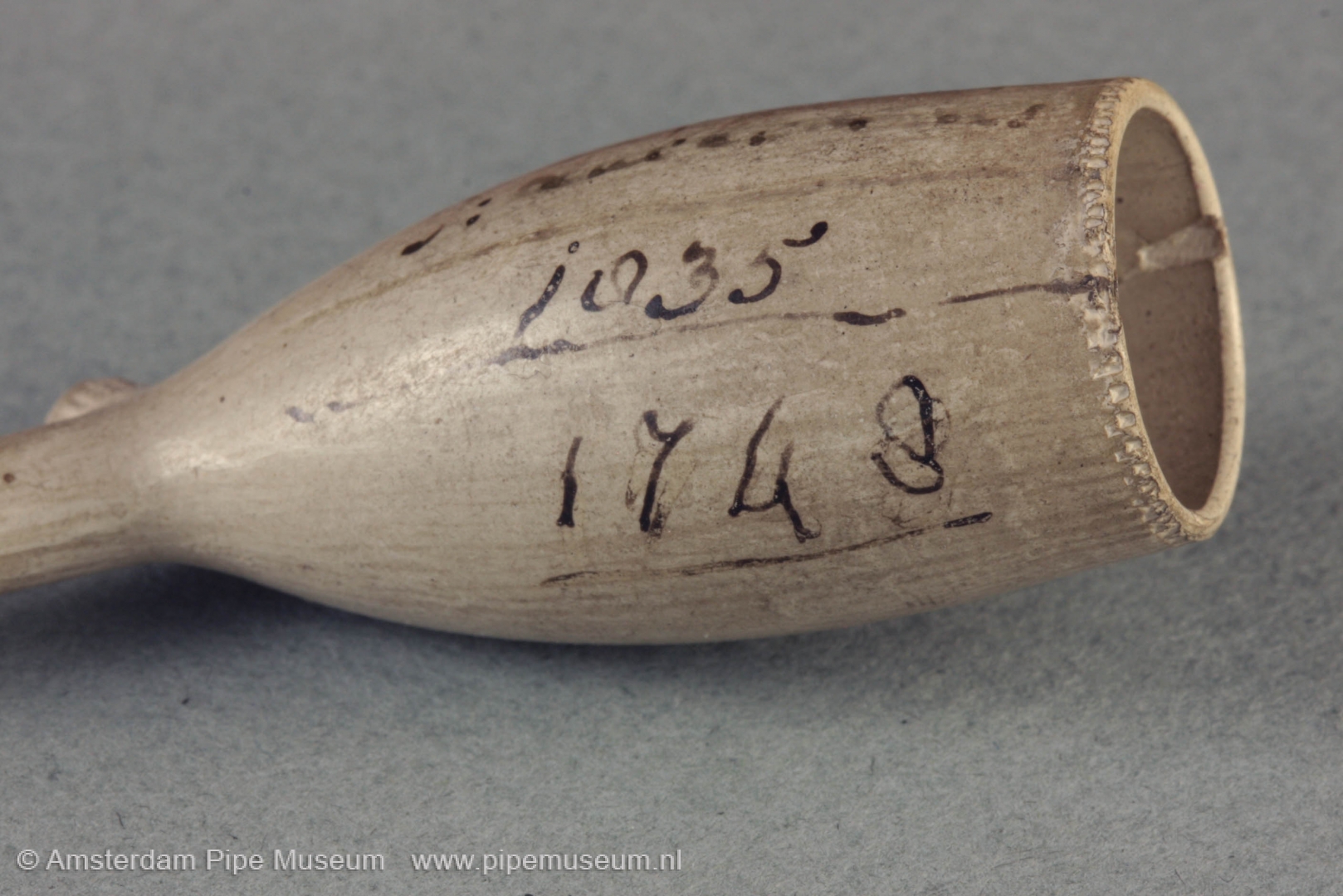
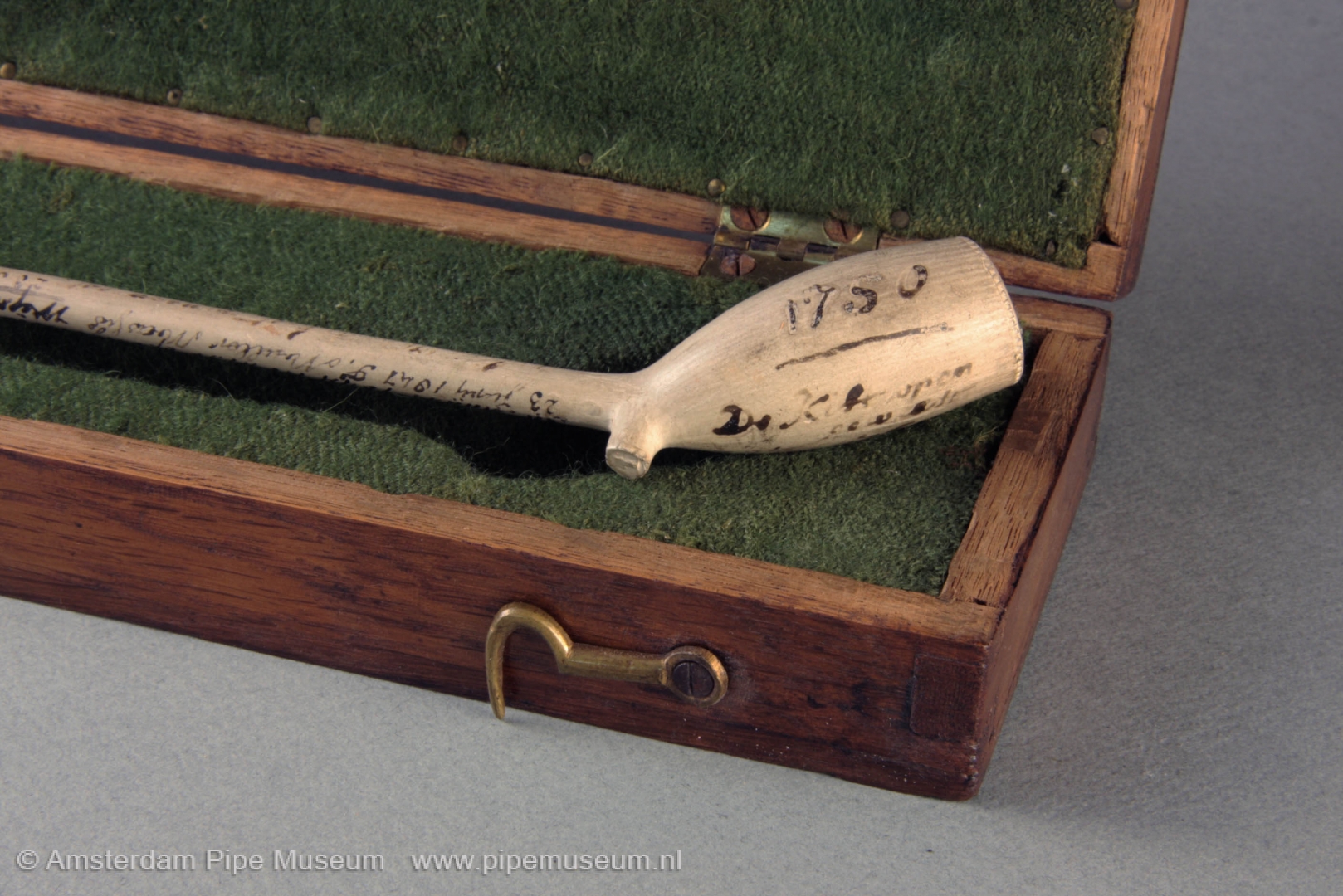
Special about this pipe is that the bowl and stem show inscriptions. It appears that this pipe was in use by the regents of the almshouse in Leiden. The series of 23 different names on the stem corresponds with the regents of this poorhouse in their respective years. It seems that the pipe has served as a ceremonial object. When the gentlemen regents met, they wrote their names and the year on the bowl or on the stem of the pipe in ink. That practice started in 1748 and continued until the last time in 1893, nearly one and a half century later!
Unfortunately, we can only guess at the circumstances of this wondrous ritual. Especially a few in-betweens give opportunity for further speculation. For example, from the inscription of 7 February 1838: the box trown away, the pipe removed or that of 30 March 1844 the box has been opened and the pipe replaced. A remarkable text is also: Congratulations to the further readers even though the word smokers had been better placed on a pipe.
The reference to box or chest in translation does not seem to refer to the wooden box of the pipe itself, but rather to a larger chest in which the pipe with case and all was kept. Did they mean the cash box of the poorhouse in which the assets were kept? In that case the names could be that of the treasurers. Strange is that the case was only opened once every few years, sometimes even at great intervals. Should the vulnerable contents of the box not be inspected more often? For the time being it seems that this mystery is not solved and that is exactly the intriguing value of this oldest preserved maatpijp. In any case one thing is certain: no-one has ever enjoyed the smoking of this pipe, tobacco has never burned in this pipe, so the bowl is still virgin white inside. A most curious museum object it is!
Amsterdam Pipe Museum APM 4.970
The cigar holder by Andries Van Houten

In the second half of the eighteenth century smoking cigars became known, initially with thin cigars that were rolled completely by hand. The taste is a new sensation for the smoker. Until now people were used to a combination of American cut tobacco mixed with local leaves from Gelderland or Alsace, the cigarillo made people get acquainted with a heavier and fuller taste. An important change was also the smokers’ appearance, who became more free, more casual. The cigar could be smoked with more nonchalance while at the same time it stood for greater luxury and a striking way of tobacco consumption.
In the Netherlands, cigar makers quickly started a production imitating the Caribbean cigars. Dutch thrift induced admixture of cheaper domestic tobacco with the positive result that the cigar was also affordable for the middle class. In order to emphasize the sophisticated way of smoking, cigar pipes appear soon on the market: simple straight tubular clay pipes in which the cigar is placed by means of a mouthpiece. They are called sigarenpen, literally cigar pin.
The pipe makers in Gouda respond to this new smoking habit and make simple cigar holders. In line with the Gouda industry, they are finished just as beautifully as the Gouda tobacco pipe. After pressing in a mould and cleaning the mould seams, the surface is polished with agate to give the pipe a nice shiny appearance. In this way they fit the luxurious cigar with its dark matt appearance that contrasts beautifully with these bright white pipes.
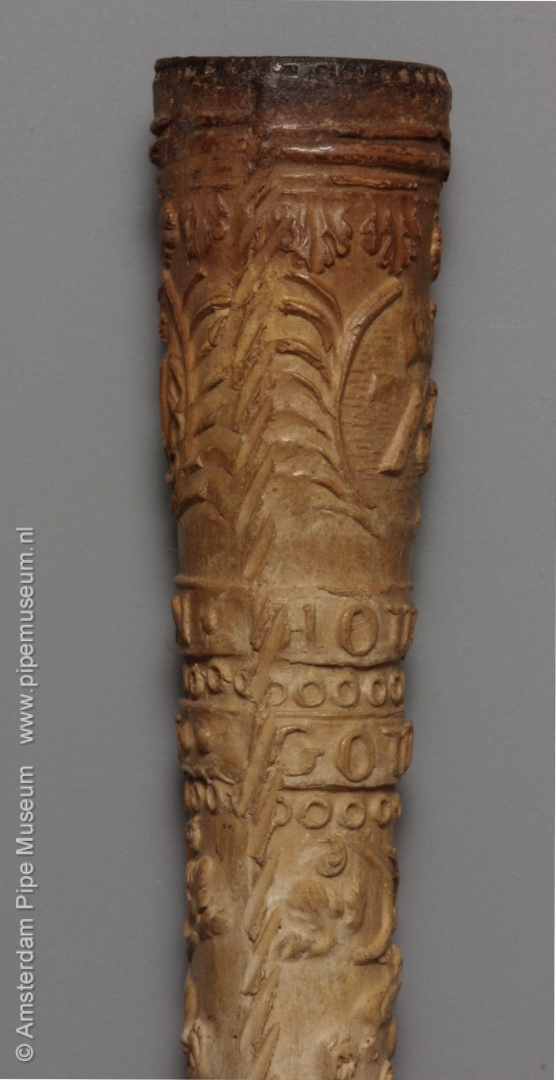
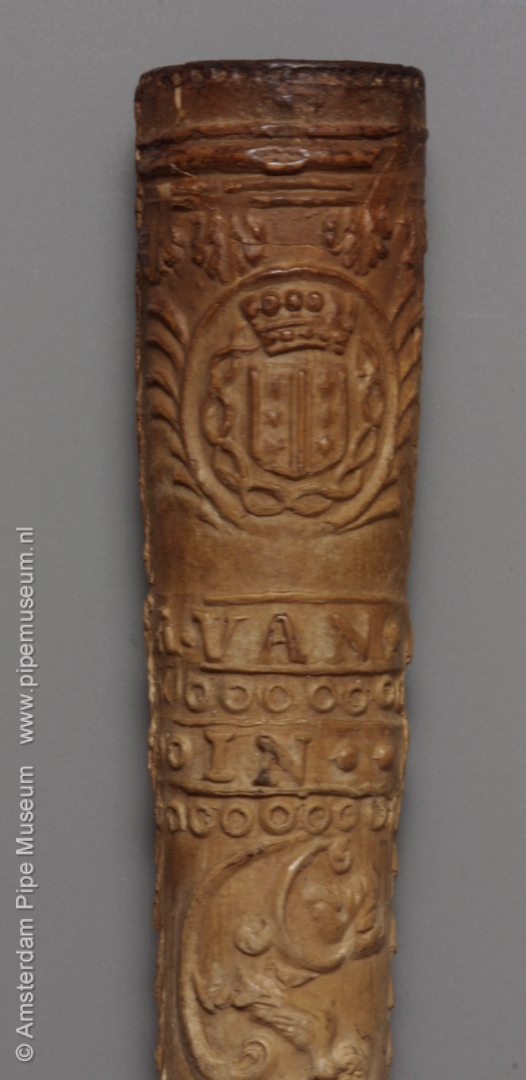
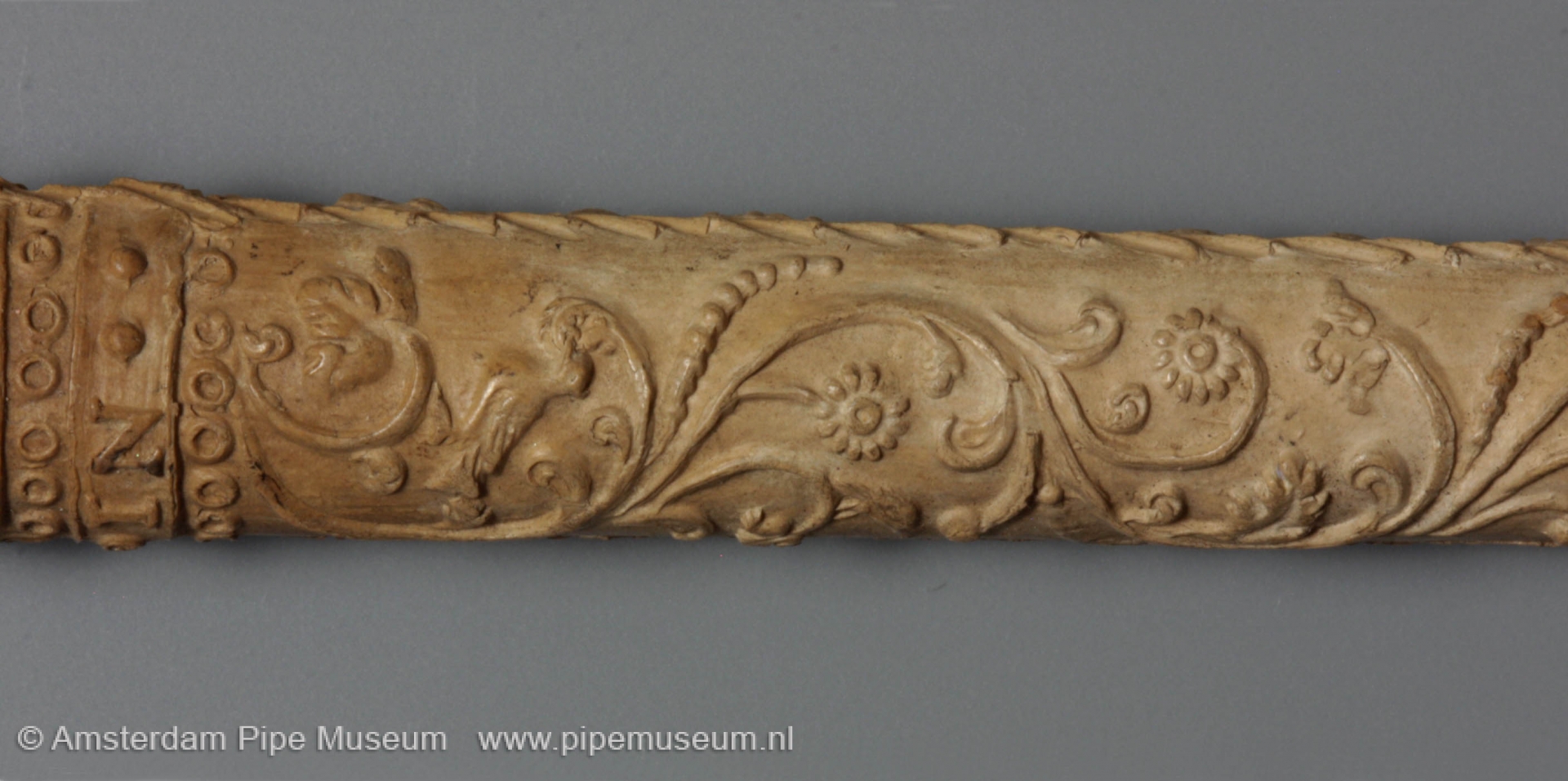
One Gouda pipe manufacturer, however, designs a cigar holder that witnesses to a special luxury and extravagance. This pipe is not short but long, measuring 21.5 centimetres. Moreover, this pipe is not smooth polished but decorated over the full length with an embossed decoration engraved in the press mould. The pattern of this decoration is based on the usual decoration on the stems of the long Gouda pipes: a meandering tendril with leaves and flowers, interspersed with some animals such as a sitting pigeon on top and between the branches two minute flying birds.
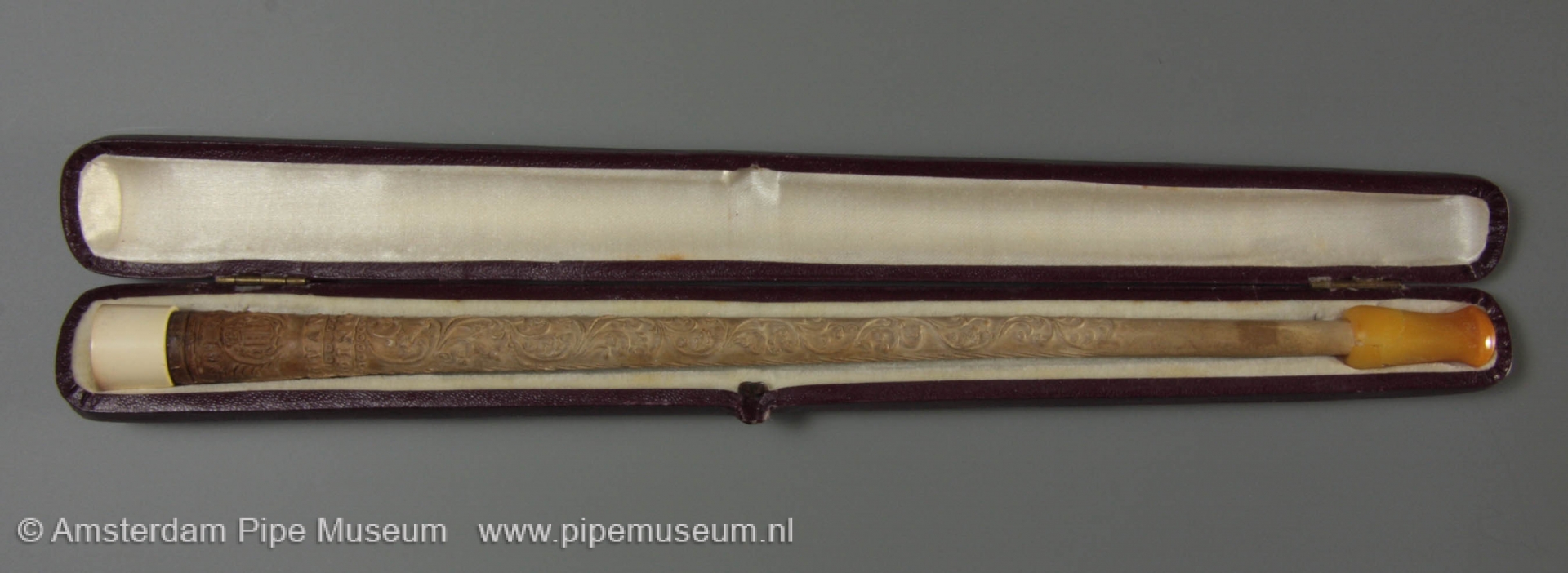
Because an explicit pipe bowl is missing in this long, tubular pipe, the bowl part remains somewhat unobtrusive even if it is marked in the decoration. On this bowl the manufacturer placed his mark crowned 73 between concentric rings with some foliage. On the reverse we see the coat of arms of Gouda in a wreath of thorns as a sign for the place of origin. The makers’ pride shows also in the addition of his name A.VAN HOUTE and IN GOUDA. It is remarkable that this exceptional pipe design is based on the well-known Gouda decoration patterns and apparently, both Van Houten and the mould maker lacked the originality to think of a completely new decoration. Even the manner of finishing testifies to a certain rigidity. For example, a milling around the bowl opening has been made, in this case actually a superfluous luxury.
The Van Houten House was a totally atypical workshop. Where most companies in Gouda focused on the standard goods and mainly specialized in a certain length and quality, Van Houten predominantly produced exceptional types. They sold these pipes as an assortment supplement to the standard products Van Houten bought from other workshops. This wonderful cigar pin fits perfectly in Van Houten's varied range.
That this fragile cigar pipe survived time is an absolute miracle. The production date will be between 1760 and 1790. The cigar holder has served as a regular pipe for years, the smoke traces testify to this. After that, the pipe will be stored as a curiosity. Eventually the object landed in Ruhla where it was mounted to German standard with a meerschaum bowl insert and an amber mouthpiece. Thanks to the fact that a protective case was added at the same time, the pipe was further safeguarded against breakage. In this way it could easily survive another century undamaged.
Amsterdam Pipe Museum APM 18.959
A figural pipe with a lid
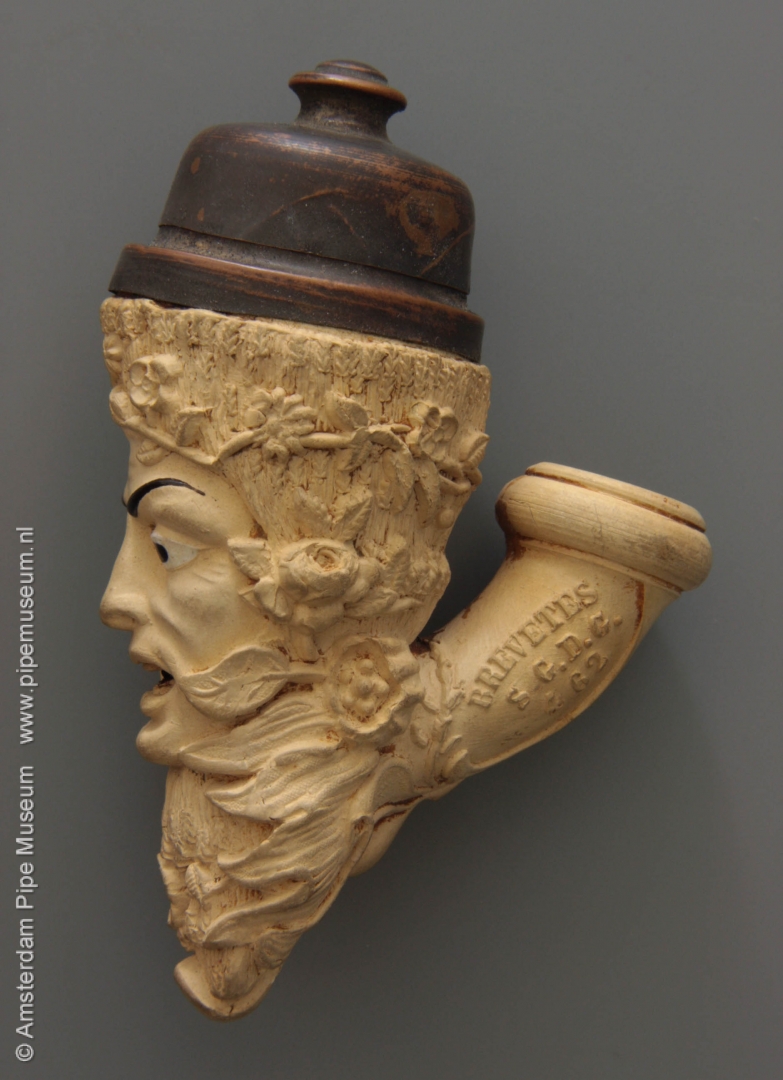
In the 1830s a new craze developed in the pipe industry. After the fashion of the figural pipe had become a great success and the pipe was the conversation piece for the smoker, a following phenomenon occurred: the lifelike portrait head that could smoke itself! Different manufacturers bring such pipes more or less simultaneously on the market. These are pipe bowls with a lid that obscures the annoying circular cut of the bowl opening and transforms the pipe into a full sculpture. Gradually that lid was provided with an added joke, which we see in the pipe shown here.
The pipe bowl shows a man's head with open mouth, a face that seems to peek between ears of corn and flowers. Undoubtedly the smoker knew exactly who was being portrayed at the time, but the meaning was lost over time. Incidentally, the face is beautifully modelled and striking is the well-formed opened mouth. With its round facial expression, the face forms a beautiful contrast with the sharp forms of the flora. The lid on the pipe bowl is part of the image: it is the hat of the person, as it were, but there is something unusual about that lid. It is not equipped with air intakes as usual to draw the pipe, but it is completely closed and that is the trick. The manufacturer introduced a smoke tube in the bowl wall from the forehead downwards up to the mouth. The mouth therefore acts as an air inlet. This system made it possible that you can simply smoke out of the pipe.
After you filled and lit the pipe, you put the lid back on the pipe bowl. If you do not smoke but blow gently into the pipe stem, the smoke starts to come out of the mouth spontaneously. What entertainment will that have given!
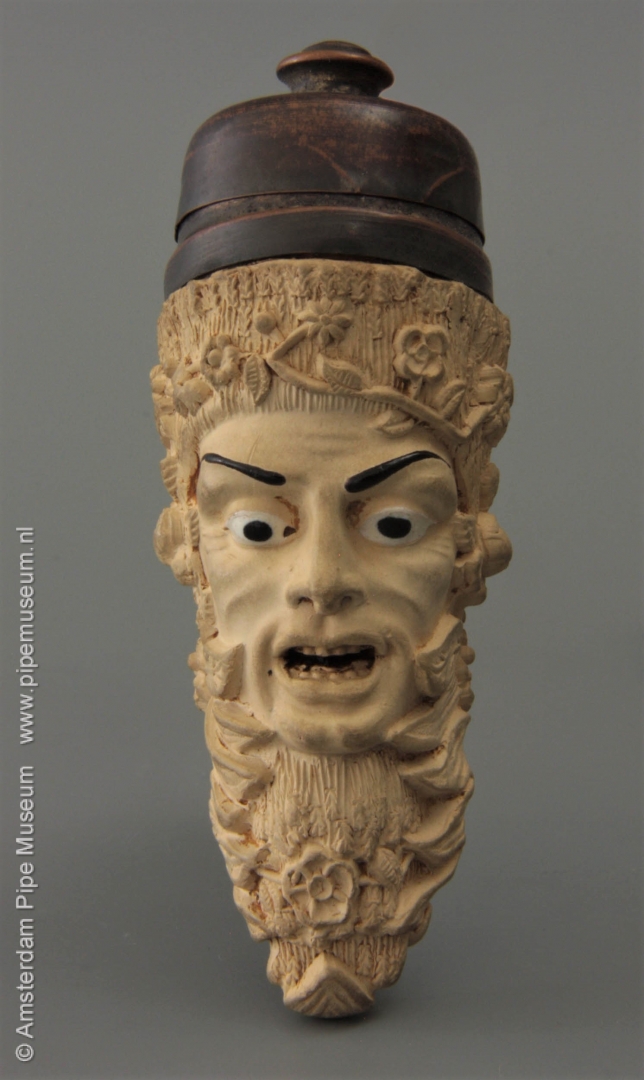
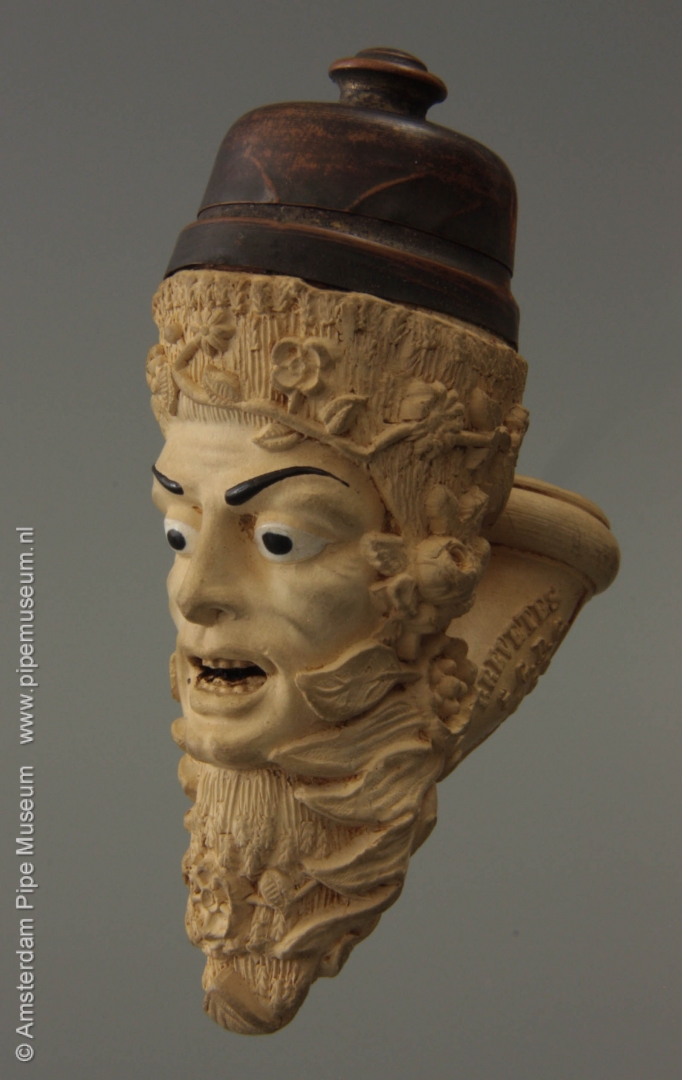
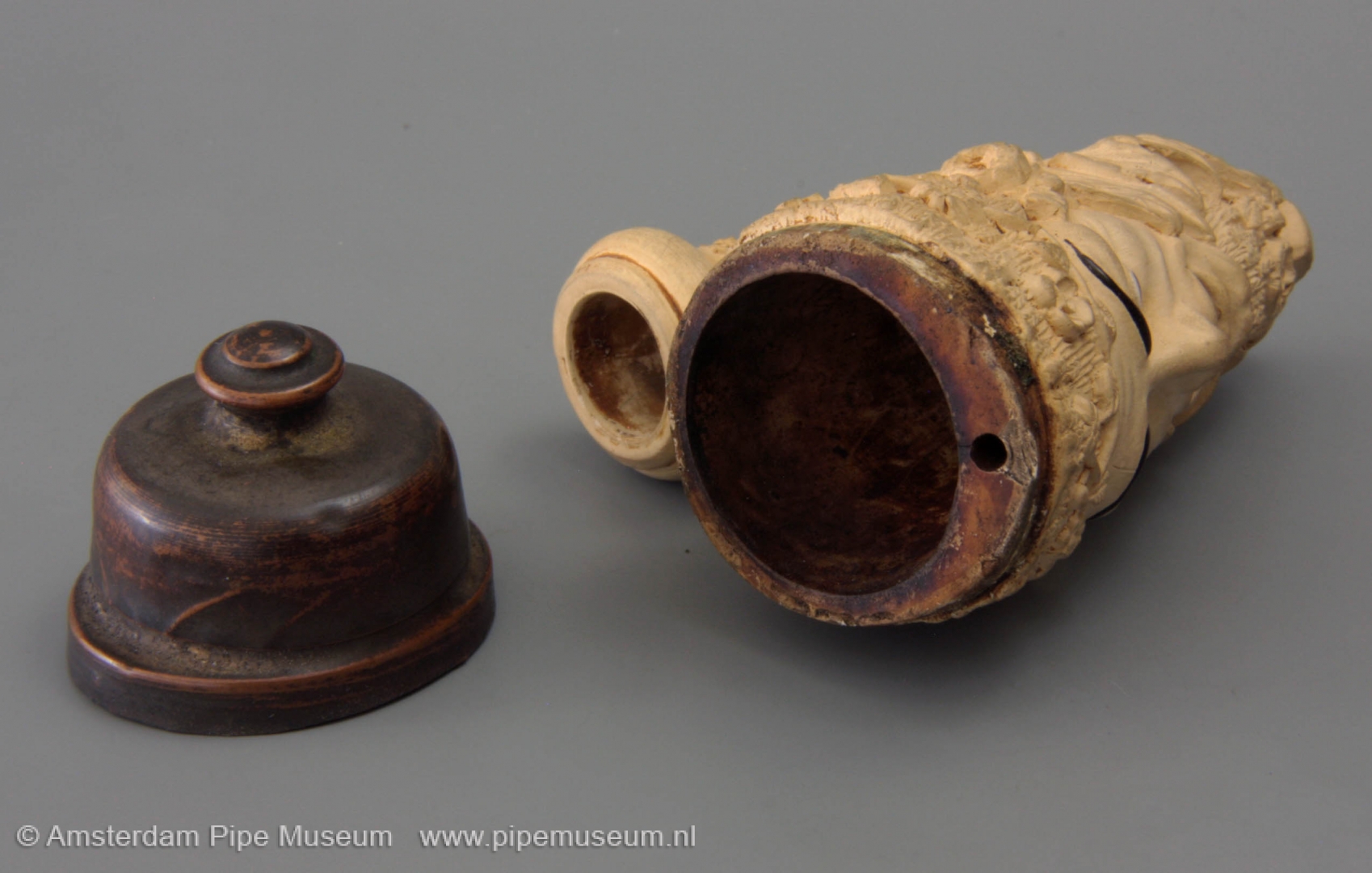
The maker is Crétal & Gallard from Rennes, an important factory we know little about. Thanks to the signature on the stem of the pipe we can make the attribution. The stem shows the shape number 462 with the addition that the design is patented, although without governmental guarantee as the inscription says. The patenting of inventions by factories was common at that time. In February 1856, Crétal & Gallard received a fifteen-year license for une pipe à trou d'air renversé as the system described here was explained. Although it seems to be a unique discovery of the Rennes factory, that may not be the case. In 1858 a patent for a similar system for Belgium was obtained by Wingender in Chokier near Liège. It is almost certain that pipes with this system were already being used extensively in France and Germany. In that respect, the patent is not always indicative for the moment of production. The pipe shown here must have been made between 1856 and 1860. Interesting to know is perhaps that in later times this model was made without the ingenious system.
Amsterdam Pipe Museum APM 9.372
Fleeing from a panther
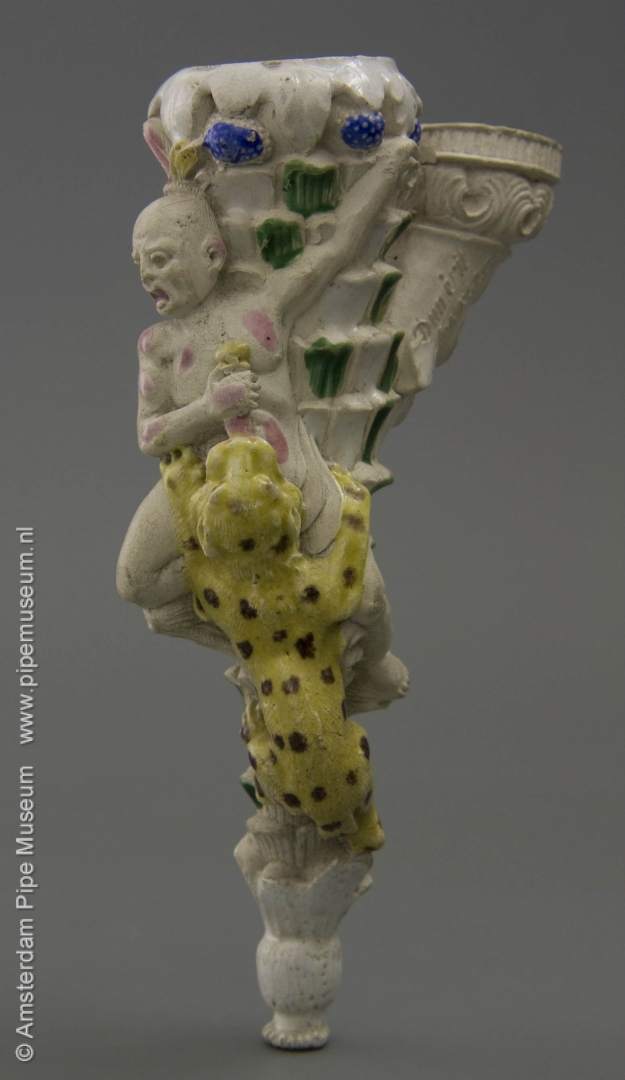
This remarkably high pipe bowl has both a unique silhouette and a special decoration. The bowl looks like the trunk of a palm tree in which a native climbs chased by a panther. The decoration is not symmetrical, but the accent has shifted slightly to one side. That is why a sitting parrot could be added on one side at the stem transition to keep the right balance in the performance. All in all, it is a exceptional design in a style that is completely fitting for the pipe making firm that produced it.
Maker is the firm Duméril & Leurs from the northern French town of Saint-Omer in Pas-de-Calais. Their pipe factory was founded in 1845 and the company soon grew thriving. The export of simple goods turned out to be particularly lucrative. There was also a department that worked for the Western European market. That is what this pipe was meant for. Artistic products with a dreamy fantasy style that could not be found in any other French pipe factory of the period. The range included several variants of these elongated bowls, for example. In terms of silhouette the same, but always with different themes. We see extremely long faces with braided beards, but also more ornamental decorations. The panther design remains one of a kind.
A characteristic of the French pipe factories was the use of enamel painting. Color accents were applied to the product with an iron hook and then baked in a special kiln. When the pipe is new it gives a colorful accent, but with use the appearance changes because the shard of the pipe gradually turns brown and the bright dots stand out as attractive color accents against the darkening background. This transformation was much appreciated by smokers.
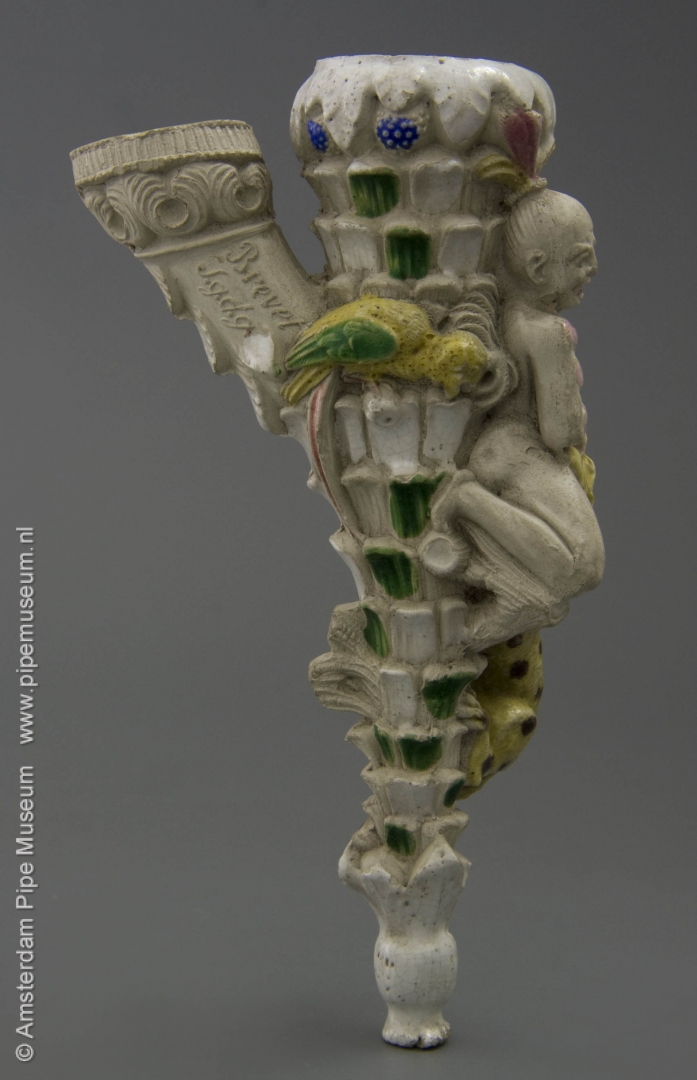
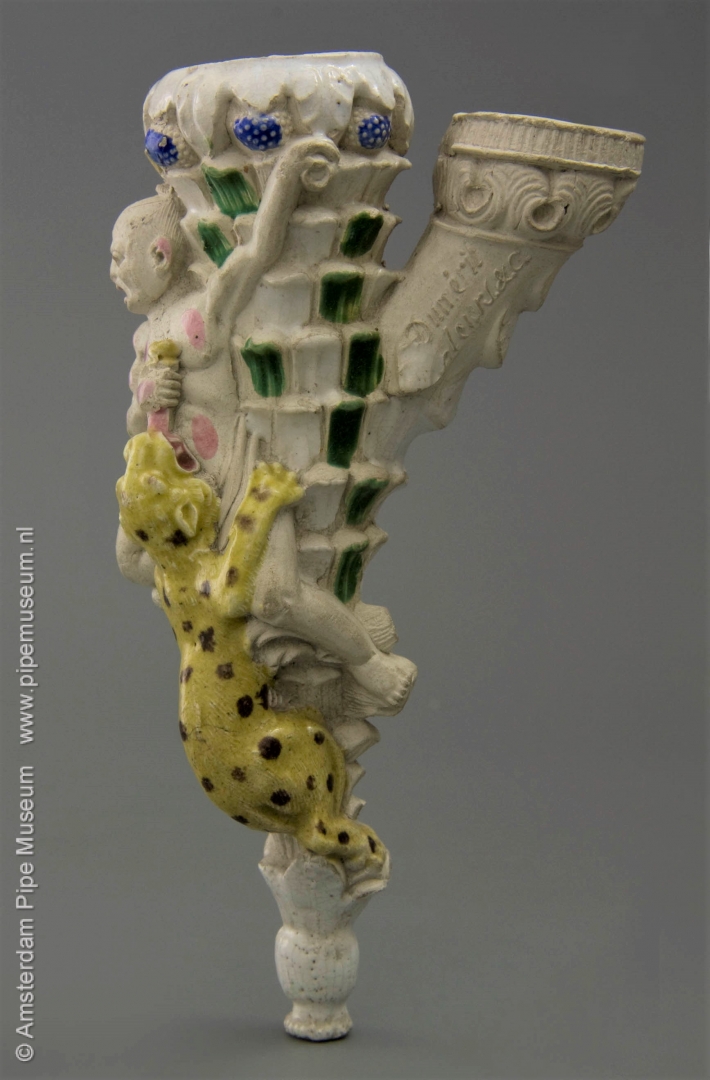
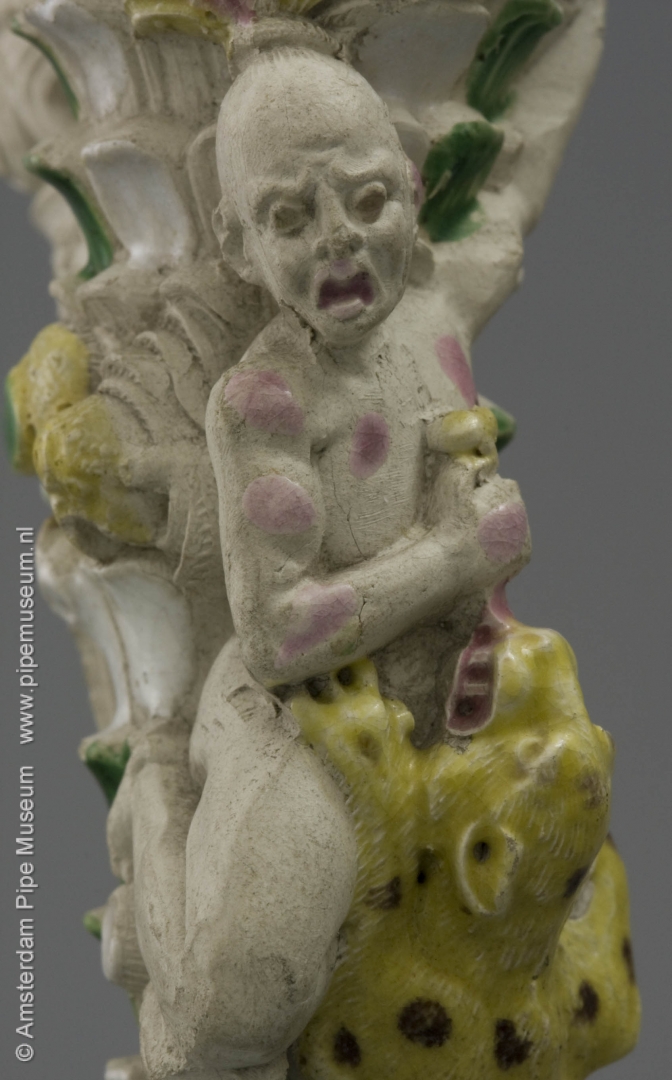
This pipe is marked on the stem. On one side we read the name of the factory in full, written in calligraphy letters. On the other side of the stem we read the mention b.s.g.d.g., which stands for breveté sans garanti du gouvernement. With this, the manufacturer announced that the design was from its own company and that other makers were in principle not allowed to copy it. Whether there was a sanction for a violation is highly questionable.
Finally, the smoking quality of the Duméril pipe cannot be left unmentioned. When it comes to a utilitarian smoking pipe, the comfort the pipe provides is of decisive importance. That is excellent with Duméril. The shard of their product is optimally porous and therefore the pipe offers maximum absorption. The use is therefore very pleasant, but on the other hand there is a negative side to the Duméril pipes. Due to its porosity, the shard is not very resistant. A Duméril pipe therefore is more fragile than a clay pipe from many other factories. That must have been the reason that the factory gradually got into financial difficulties and could not survive in the long run. As early as around 1880, production was downsized and new models were no longer created. The company closed its doors permanently in 1885, after 40 years of activity. Because part of the showroom collection ended up in the municipal museum, the Duméril firm is now extremely well represented from a museum point of view. However, outside of this unique corporate collection in Saint-Omer, Duméril pipes are extremely rare. This perfectly intact item in our collection is rightly one of the highlights.
Amsterdam Pipe Museum APM 21.465
Braided pipes for the queen
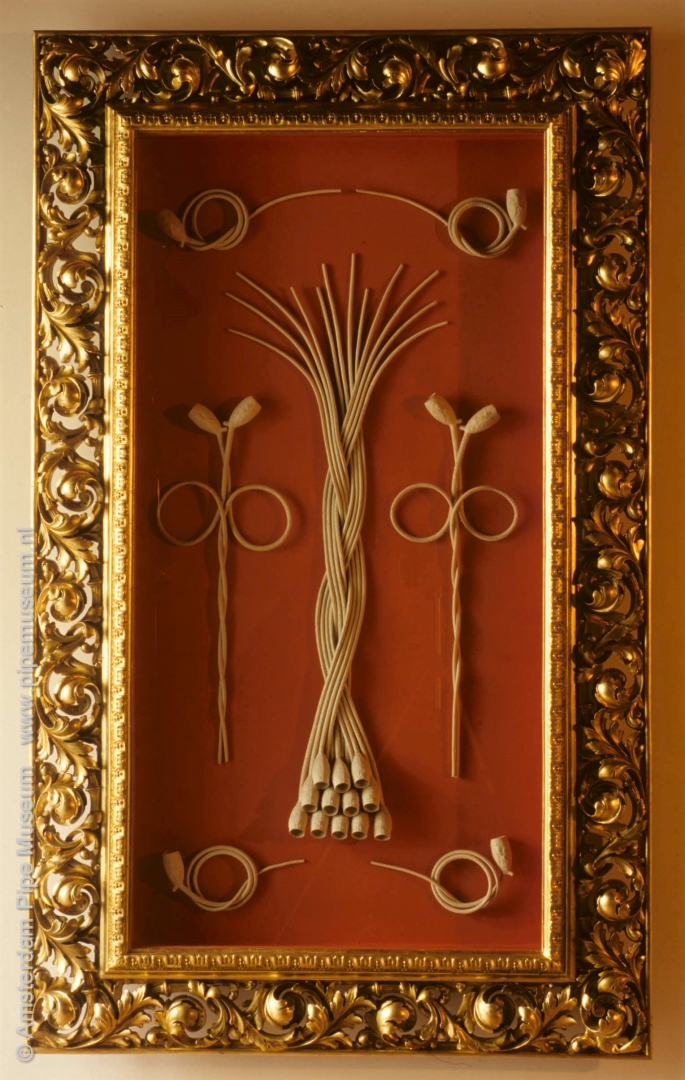
For the residents of Gouda, 24 April 1897 was a special day. On that date, Queen Regent Emma and her daughter Princess Wilhelmina would visit the city of Gouda. The program included a visit to the candle factory and a look at the Saint Johns’ Church for the famous stained glass windows, next to a visit to a pipe factory. The honour for the visit of a pipe factory was given to the firm P. Goedewaagen & Son, not surprising because the firm's owner, Pieter Goedewaagen, was member of the municipal board of Gouda.
The local newspaper Goudsche Courant gives an impression of the preparations for the Royal visit one day before the event. It turns out that at Goedewaagen the entire factory has been cleaned, an impossible task in a ceramic factory full of clay dust. At the entrance of the factory, a sort of boudoir was arranged to receive the Queen Mother and her daughter in a dignified way. On the way to this reception hall they built a canopy consisting entirely of long stemmed Gouda pipes.
A day later we read an extensive report in the local newspaper. The queens have then seen the longest kind of pipes being made by the most skilled master pipe makers. The other workers were watching along the wall dressed in their Sunday suit. This longest type of pipe is decorated with the coat of arms of the House Hannover, in fact the English royal family, but for the occasion the pipes were renamed pipes with the arms of Stadholder-King William III. A dozen of the long clay pipes made in presence of the two royals were pleached into an exceptional plait. Around it are some other figures that make the whole into an art work of clay pipes.
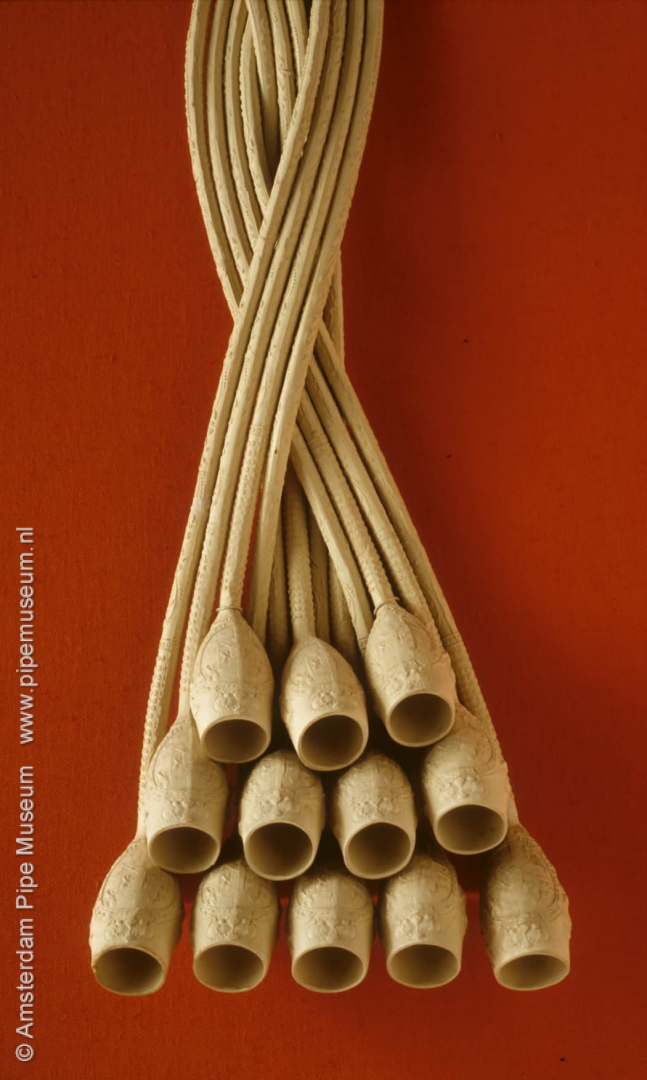
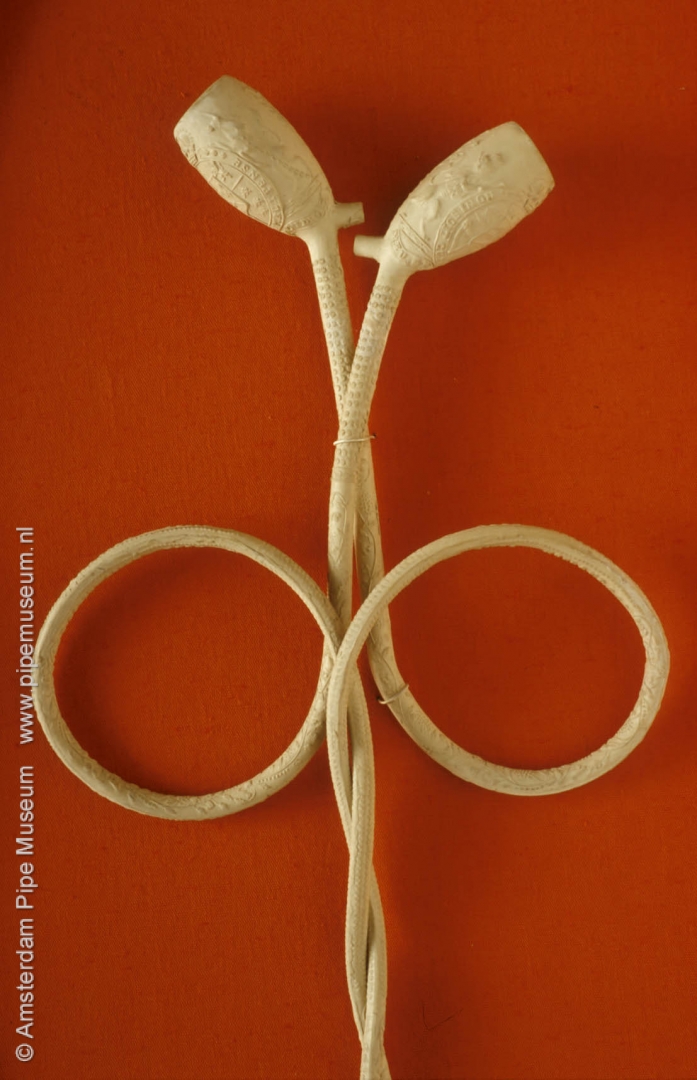
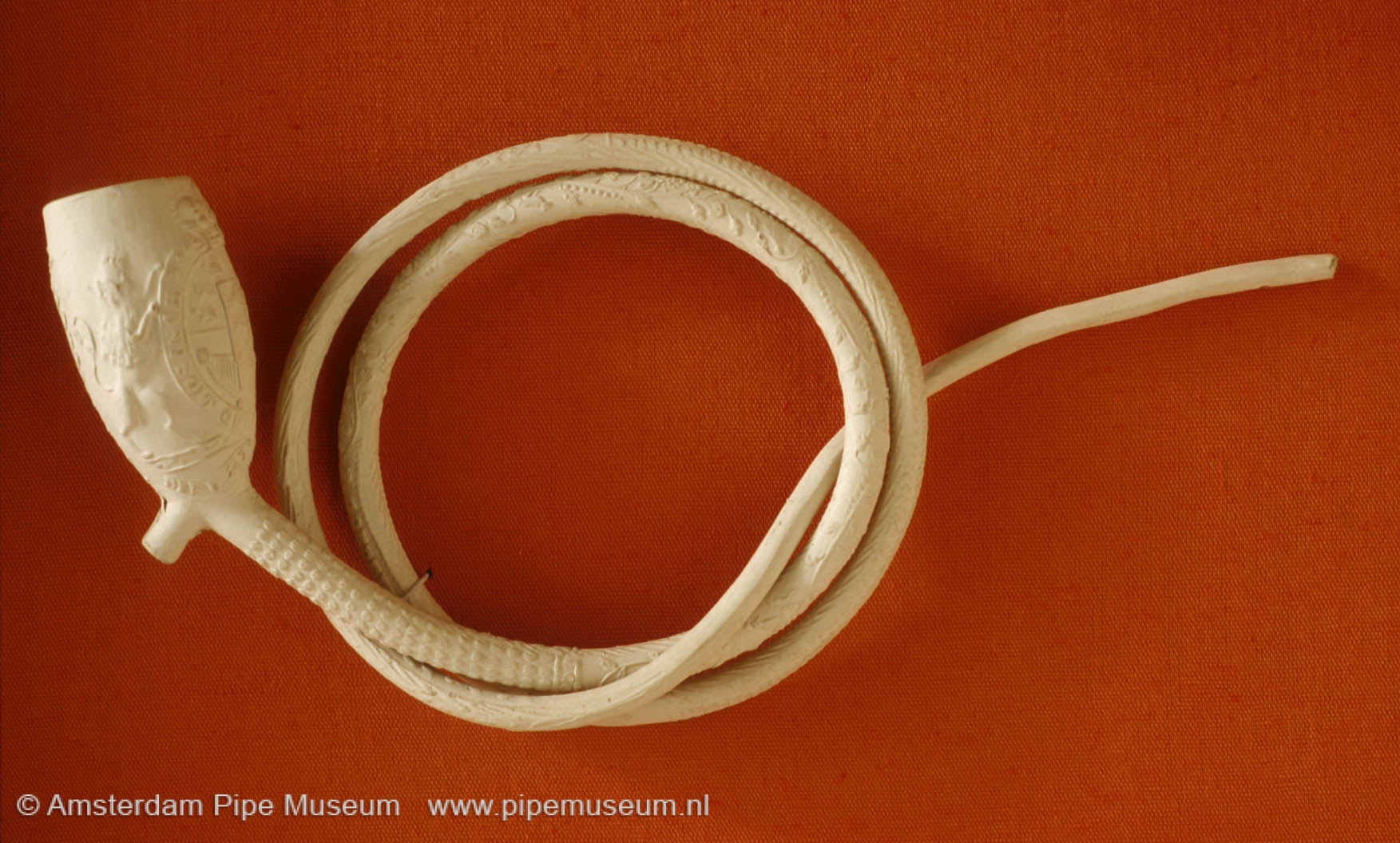
After the visit the braided pipes were baked and were given a place in the reception room of the factory as a reminder of the royal visit. The fact that the manufacturer was very honoured is also apparent from a silk-bound guest book, in which the two queens have written their names with the addition of the date of their visit. On the cover of this beautiful cahier, the Dutch coat of arms is printed in gold. That book was since then shown at the reception of important relations.
Until the 1970s, the artwork of pipes hung in the Koninklijke Goedewaagen factory. Initially on the Raam, from 1909 in a brand new factory building along the Nieuwe Vaart. In the 1950s the piece moved from the showroom to the boardroom. At that time it was incorporated in a modern wooden panelling. It was not dismantled until 1974 and two years later this special object was transferred to the Pijpenkabinet Foundation. The factory management found a museum destination more appropriate and safe in the harsh economic situation. The original frame has been restored since then and the object could be exhibited in its original way. It is now in full glory as one of the most special clay pipes in the main chamber of the Amsterdam Pipe Museum.
Literature: D.H. Duco, De tabakspijp als Oranjepropaganda (The tobacco pipe as propaganda for the House of Orange), Leiden, 1992, p 83-86.
Video: Pipes for the Queen
Amsterdam Pipe Museum APM 10.831